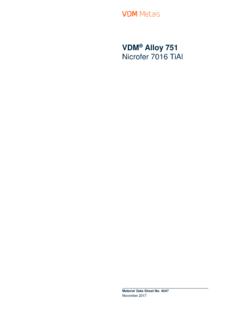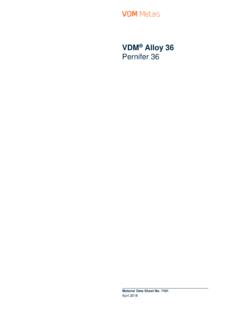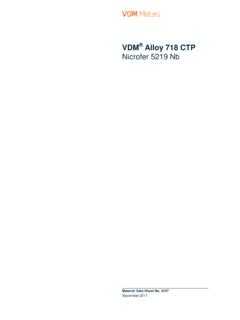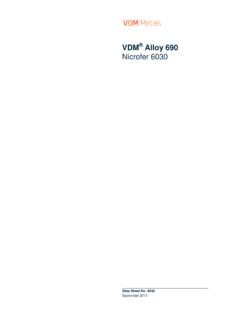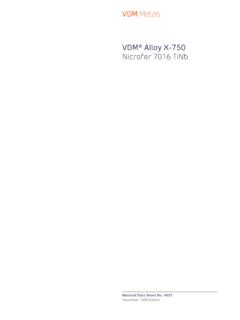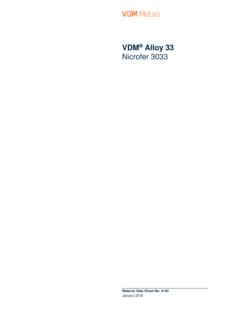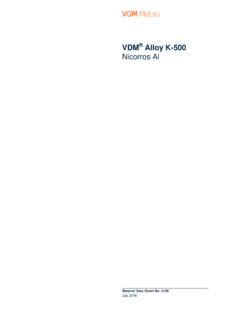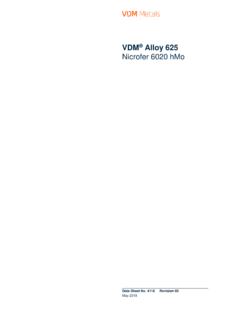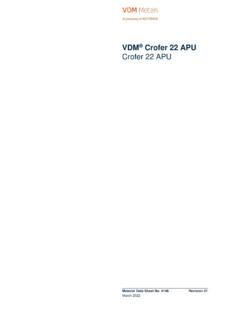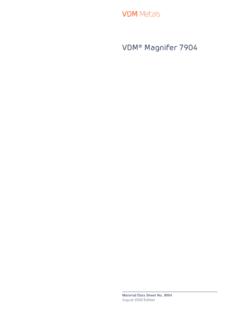Transcription of VDM Alloy 926 Cronifer 1925 hMo - VDM Metals
1 VDM Alloy 926 Cronifer 1925 hMo Material Data Sheet No. 5102 September 2017 September 2017 VDM Alloy 926 2 VDM Alloy 926 is an austenitic, special stainless steel that was developed by VDM Metals on the basis of the many times proven VDM Alloy 904 L ( ). Due to its % higher molybdenum concentration, VDM Alloy 926 has a generally improved corrosion resistance and resistance against pitting corrosion and crevice corrosion compared to VDM Alloy 904 L. This also has a positive effect on the resistance against stress corrosion that is induced by pitting corrosion. VDM Alloy 926 is characterized by: very good resistance against chloride-induced stress corrosion, increased resistance against stress corrosion in comparison to other austenitic stainless steels, excellent general corrosion resistance when in contact with oxidizing and reducing media, higher strength than VDM Alloy 904 L ( ), low propensity to form inter-metallic phases, Approval for pressure vessels in the temperature range from -196 to 400 C ( to 752 F).
2 Approval from building supervisory authorities for components and joining elements made of stainless steels, Deutsches Institut f r Bautechnik [German Centre of Competence for Construction], September 98 Designations Standard Material designation EN X1 NiCrMoCuN25-20-7 UNS N08926 Standards Product form DIN VdT V ASTM ASME EN Others Sheet EN10088-2 EN10028-7 502 A 240 Strip EN 10028 EN 10088-2 A 240 B 625 SA 240 SB 625 API 5LD Bar EN10088-3 502 502 B 649 SB 649 10222 NACE 0175/ISO15156 Wire EN 10088-2 Table 1 Designations and standards VDM Alloy 926 Cronifer 1925 hMo September 2017 VDM Alloy 926 3 Chemical composition C S N Cr Ni Mn Si Mo Cu P Min. Max. Overall analysis corresponds to VdT V sheet 502 Due to technical reasons the Alloy may contain additional elements Table 2 Chemical composition (%) Physical properties Density Melting range Relative magnetic permeability at 20 C (68 F) g/m bei 20 C 506 lb/ft3 at 68 F 1,320 - 1,390 C (2,408 - 2,534 F) Temperature Specific heat capacity Thermal conductivity Electrical resistivity Modulus of elasticity Coefficient of thermal ex-pansion C F JKg K Btulb F Wm K Btu insq.
3 Ft h F cm GPa 106 psi 10-6K 10-6 F 20 68 415 96 193 - - 100 212 435 99 186 200 392 470 104 179 300 572 495 108 173 400 752 510 112 168 Table 3 Typical physical properties at room- and elevated temperatures September 2017 VDM Alloy 926 4 Microstructural properties VDM Alloy 926 has a cubic, face-centered crystal structure. Mechanical properties The following properties at room and elevated temperatures apply to VDM Alloy 926 in the solution-annealed condition and for the specified dimensions. The properties for larger dimensions must be agreed separately. The values are valid for longitudinal and traverse test samples. Temperature Yield strength Rp Yield strength Rp C F MPa ksi MPa ksi 20 68 300 340 100 212 230 270 200 392 190 225 300 572 170 205 400 752 160 190 500 932 120 150 550 1022 105 135 Table 4 Mechanical properties at elevated temperatures, min.
4 Values according to VdT V material data sheet 502 Product form Dimensions Yield stress Rp 0,2 Yield stress Rp 1,0 Tensile strength Rm Elongation at fracture1) A mm in MPa ksi MPa ksi MPa ksi % Sheet 50 300 340 600 800 87-116 40 Strip 3 300 340 600 800 87-116 40 ar 300 300 340 600 800 87-116 40 1) Elongation at fracture: for flat products < 3mm ( in) with lengthwise minimum values reduced by 5% - points Table 5 Mechanical properties at room temperature ISO V notch impact toughness Temperature Notched-bar impact strength (J/cm ) -196 C (-321 F) 125 20 C (68 F) 150 Table 6 The results of the notched-bar impact-bending test at the V-trial according to DIN EN ISO 148 -1 minimum average value of three trials (min. single value must not be less than 105 J/cm at 20 C resp. 88 J/cm at -196 C). September 2017 VDM Alloy 926 5 Corrosion resistance VDM Alloy 926 is an austenitic, special stainless steel with largely the same chemical composition as VDM Alloy 904 L, while the nitrogen content was raised to % and the molybdenum concentration to about %.
5 At the same time, the resistance against stress crack corrosion induced by pitting corrosion is improved. The nitrogen concentration raised to rounded % improve the austenite stability and lowers the propensity to form inter-metallic phases. VDM Alloy 926 is a good pick for media such as diluted sulfuric and phosphorus acids that are contaminated with chlorides, and also for salt concentrations and crystallizations against which the material proves a higher resistance against wear and tear. Due to its good corrosion resistance in seawater, VDM Alloy 926 is also used for facilities on offshore platforms. The optimal corrosion behavior is only given if the material is used in clean, passivated condition. Fig. 1 Critical pitting corrosion temperature in 10 % FeCI3 x6H2O solution as a function of the effective sum in com-parison to some stainless steels and nickel alloys .
6 Fig. 2 Time-temperature sensitization diagram (ZTS) of VDM Alloy 926 September 2017 VDM Alloy 926 6 Applications Typical applications for VDM Alloy 926 are: Vaporizers, heat exchangers, tank housings, etc. in phosphorus acid production Facilities and pipework in the use of diluted sulfuric and phosphorus acid, even if these are contaminated with chlorides Distributor systems and coolers for sulfuric acid plants Concentration and crystallization plants in salt extraction by vaporization Fire extinguishing systems, sea water filtration, hydraulics and injection systems of off-shore engineering Pump frames of oil extraction pumps Pump lines and couplings, wire lines in oil and gas extraction Condenser pipes and pipework systems in power plants with heavily contaminated cooling water Parts for flue gas desulfurization that are exposed to modest corrosion strain Facilities and parts for the bleaching phase of the pulp industry Flexible pipes in the off-shore industry Tanks for storing and transport of aggressive chemical substances September 2017 VDM Alloy 926 7 Fabrication and heat treatment VDM Alloy 926 is ideally suited for processing by means of common industrial processing techniques.
7 Heating It is important that the workpieces are clean and free of any contaminations before and during heat treatment. Sulfur, phosphorus, lead and other low-melting point Metals can result in material damage during the heat treatment. This type of contamination is also contained in marking and temperature-indicating paints or pens, and also in lubricating grease, oils, fuels and similar materials. The sulfur content of fuels must be as low as possible. Natural gas should contain less than of sulfur. Heating oil with a maximum sulfur content of is also suitable. Electric furnaces are preferable for their precise temperature control and a lack of contaminations from fuels. The furnace temperature should be set between neutral and slightly oxidizing and it should not change between oxidizing and reducing. The workpieces must not come in direct contact with flames.
8 Hot forming VDM Alloy 926 can be hot-formed in a temperature range between 1,200 and 900 C (2,192 and 1,652 F) with subse-quent rapid cooling down in water or air. For heating up, workpieces should be placed in a furnace that is already heated up to 1,200 C (2,192 F). Heat treatment after hot forming is recommended for achieving optimal corrosion behavior. Cold forming The workpieces should be in the annealed condition for cold forming. Due to its high molybdenum concentration, VDM Alloy 926 has a higher work hardening rate than other austenitic stainless steels. This must be taken into account for the design and selection of forming tools and equipment and during the planning of forming processes. Intermediate annealing is necessary for major cold forming work. For cold forming above 15%, a final solution annealing must be conducted. Heat treatment Solution annealing should take place at temperatures between 1,150 to -1,200 C (2,102 to -2,192 F) and preferably at 1,180 C (2,156 F).
9 The retention time during annealing depends on the semi-finished product thickness and can be calculated as follows: For thicknesses of d <= 10 mm ( in), the retention time is t = d 3 min / mm For thicknesses of d = 10 to 20 mm ( in to in), the retention time t = 30 min + (d 10 mm) 2 min/mm For thicknesses of d > 20 mm ( in), the retention time t = 50 min + (d 20 mm) 1 min / mm The retention time starts with material temperature equalization; longer times are generally considerably less critical than retention times that are too short. Cooling down should be accelerated with water to achieve optimum properties. Fast air cooling can also be carried out at thicknesses of less than approx. mm. The material must be placed in a furnace that has been heated up to the maximum annealing temperature before any heat treatment. For strips as the product form, the heat treatment can be performed in a continuous furnace at a speed and temperature that is adapted to the strip thickness.
10 Descaling and pickling Oxides of VDM Alloy 926 and heat tint in the area around welds adhere more strongly than in stainless steels. Grinding using extremely fine abrasive belts or grinding discs is recommended. It is imperative that grinding burns be avoided. Before pickling in nitric-hydrofluoric acid mixtures, the oxide layers should be destroyed by abrasive blasting or fine grind-ing, or pre-treated in salt baths. The pickling baths used should be carefully monitored with regard to concentration and temperature. September 2017 VDM Alloy 926 8 Machining VDM Alloy 926 is preferably processed in annealed condition. Since the Alloy is prone to work hardening, a low cutting speed should be selected with a feed speed that is not too high and the cutting tool should stay engaged at all times. An adequate chip depth is important in order to cut below the previously formed work-hardened zone.
